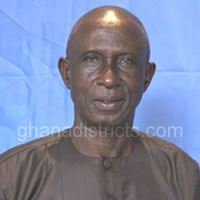Municipal Scalogram
Functional Hierarchy of Settlements and Its Implications
this section discusses the spatial organization of activities within the Berekum Municipality. It deals with the type, number, and distribution of facilities and services within the Municipality. It provides a summary of the current socio-economic profile with a spatial dimension.
These settlements were ranked based on both population and the number and the type of services and facilities they offer. The distribution of facilities and services and settlements are presented in figure 3. Settlements were first arranged in descending order of their population.
Twenty-Eight (28) settlements with population above 500 in 2004 were taken into consideration. A total of 44 functions/services were considered. Berekum with a population of over 44,000 was ranked first followed by Jinijini with a population of 15,600. The last settlement considered was Benkasa.
The functions and services were weighted according to their level of complexity. This represents the degree to which each of the identified settlements provides function to people in other parts of the Municipality. Total centrality for each settlement was then calculated.
Hierarchy Of Settlements
Based on the population and the number of services or facilities, the levels of settlements were identified as follows:
1st Order settlement,
2nd Order settlement,
3rd Order settlements
4th Order settlements
Weights were given to the various services and facilities and the total centrality index which represents the degree to which each of the settlements provide functions to people in other areas was then calculated.
Settlements with centrality index above 7,000, formed the 1st order settlement. While settlement with centrality index of 1,506.7 formed the 2nd Order settlement. Centrality score between 102.7 and 238 formed the 3rd order settlements and centrality score between 41.1 and 86.0 formed the 4th order settlements.
Environmental Situation
Environmental Situation The Built Environment
Generally, there is lack of proper and adequate drainage system in the Municipality. With the exception of the district capital, which has some few stretches of drains, all other settlements do not have drains. Given this lack of general drains , its is no wonder that 36 percent and 48 percent of houses in the urban and rural areas respectively have exposed foundations.
Erosion
Arising from lack of drain as mentioned above and coupled with high amount of rainfall received, most of the settlements have problems with erosion.
The Natural Environment
Again the exploitation of the forest for timber resources by ABTS and other timber firms, also contribute towards the destruction of the natural environment. Even though isolated cases have been reported from time to time, the incidence of bush fire in Berekum as of now, it is not very rampant as obtains in other districts. The Municipal Assembly has established community fire volunteers groups to prevent and combat bush fires. This should be sustained. However, since the devastating effects of fire are not a function of its frequency, new and constant surveillances and strategies are required to tackle any insurgence of bush fire.
Spatial Organization/Human Settlement Pattern Hierarcy Of Settlements Hierarchy of settlements by population and by service was addressed among other spatial issues. The Municipal total population of 113,650 is unevenly distributed in the various settlements.
Berekum which happens to be the Municipal capital has almost a half (1/2) of the total population. And due to its continued expansion, it is gradually absorbing certain nearby communities such as Kato, Senase, Jamdede and Kutre No II.
This can also be attributed to the fact that it lies along a major road i.e.Sunyani through to Dormaa. Besides, the Municipal weekly market and the Holy Family Hospital, are all located in Berekum, thus encouraging a lot of economic activities, as a result many inhabitants at the other settlements move to settlements nearer into the Municipal and also into the capital.
Findings:
Berekum is gradually turning into a form of conurbation.
The Municipal has only four towns using a standard threshold population of 5,000 as a basis of classifying a community as an Urban. These are Berekum (48,331), Jinijini (7,809), Senase (6,754) and Kato (5,466).
Date Created : 11/15/2017 5:45:48 AM





 facebook
facebook X (twitter)
X (twitter) Youtube
Youtube +233 593 831 280
+233 593 831 280 0800 430 430
0800 430 430 GPS: GE-231-4383
GPS: GE-231-4383 info@ghanadistricts.com
info@ghanadistricts.com Box GP1044, Accra, Ghana
Box GP1044, Accra, Ghana